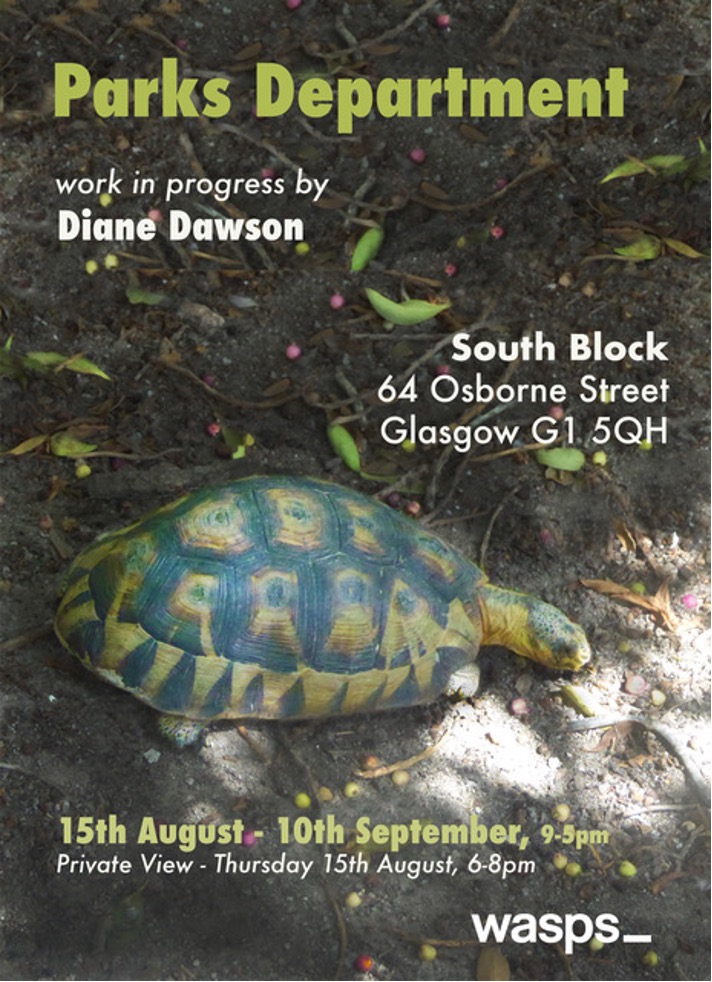
‘Parks Department’ exhibition at WASPS Studios. © Alan Dimmick
Diane Dawson Talks Urban Jungles, Hidden Layers, and Animal Actors in Glasgow’s Art Scene
While the Fringe rages on in Edinburgh, Scotland’s art capital, it’s in Glasgow where a deeply connected community of artists thrives. The ‘creative quarter’, as artist Diane Dawson calls it, pulsates with life in the city’s hidden belly.
On first glance, you’d be forgiven for thinking that ‘Parks Department’ is an oddly matched collection of images. But look longer and you’ll see that it’s actually strangely familiar. Look closer and you’ll even see your own reflection — literally.
Brick high rises and exotic animals. Ice cream vans and festive bunting. These details, laughably disparate when separated as they are in this exhibition, undeniably compose the worlds many of us inhabit: constructed spaces awash with animals and soft decorations. It’s a place that, to outsiders, might appear as a mess of unsimilar things, but to us, makes perfect sense.
Diane’s work forces us to confront these constructed environments. However, it’s her playful manner that makes this confrontation not just palatable, but enjoyable — even nostalgic for some. As you gaze at the images printed on mirrors, you can’t help but see your own reflection, creating a forced familiarity that’s both unsettling and intriguing.
“For ‘Parks Department’ I started with thinking about the animals who are out of place, but presented for our civic enjoyment (the fish) and the unstoppable animals who claim as much right to enjoy the parks as we do,” she explains.
The exhibition showcases Diane’s experimentation with different surfaces and techniques, mixing mediums to push the boundaries of printmaking. Each piece contributes to a larger narrative, inviting viewers to consider the complex relationships between urban spaces, their inhabitants, and the natural world. But how did she arrive at this unique artistic vision?
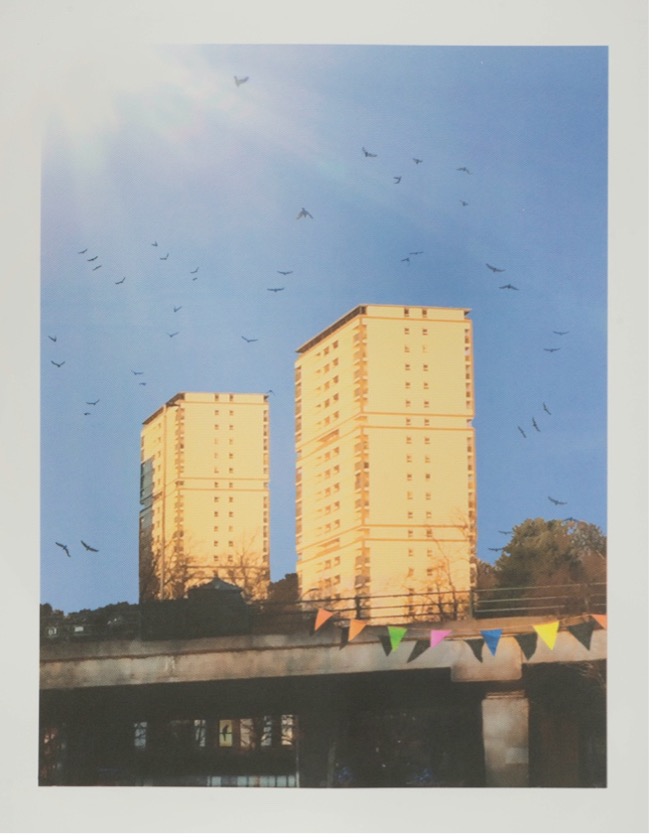
‘Magic Roundabout’, Silkscreen. © Alan Dimmick
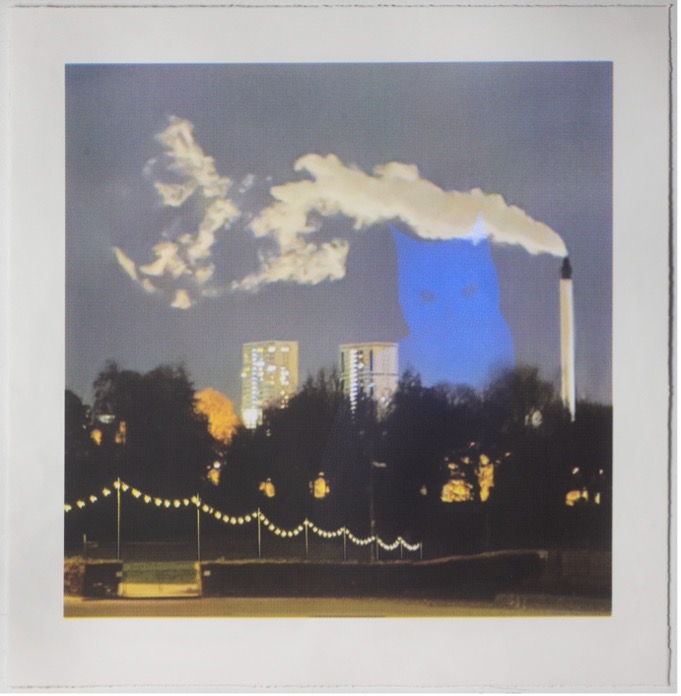
‘I Declare’, Silkscreen with UV Overlay. © Alan Dimmick
Her artistic journey began more recently than one might expect, profoundly shaping her career. “I often say that if I had gone to art school straight from school I would not necessarily have become an artist,” she reflects. Her later return to art education proved pivotal. “Studying later in life definitely gave me an awareness of the value of the opportunity and allowed me to focus on just making work.”
This choice, far from being a last chance, became the foundation of her current success. Interestingly, Diane’s path has inspired others; she shared that another woman decided to pursue art school after learning of her experience, adding ‘influencer’ to her growing list of titles.
It was during her fourth year at art school that Diane began exploring the themes that still dominate her work today. Drawing from her experience of growing up in a Scottish New Town, she started investigating how our surroundings influence not just who we are, but what society expects of us.
“This was when I started to really think about how our environments can shape not just who we are, but what is expected of us on a social level, how we ‘perform’,” she explains. Her insights led her to unexpected parallels: “At this point I drew connections with other performing environments, such as zoos and circuses, which was where the use of animals came into the work.”

‘The Screech’, Silkscreen on Mirror. © Alan Dimmick

‘The Urban Carpet’, Silkscreen on Mirror. © Alan Dimmick
This exploration evolved into one of the most striking aspects of Diane’s work: her use of exotic animals in manmade environments, creating a tension that speaks to themes of belonging and displacement. “I employ them in my work as character actors, giving them roles in the narrative,” she says. “I use animals, to quite literally mirror human, social behaviour and explore the idea of our personal territory being the starting point for how we enact in our society.”
This approach allows her to explore complex social themes with a lightness that makes her work accessible. While not intentionally humorous, her natural wit often finds its way into her pieces, allowing viewers different levels of access to the sometimes-challenging themes she explores.
“I am a naturally humorous person and so as part of my personality that will always find its way into my work,” Diane admits. “But I’m not trying to be funny in the work I make, more to employ a lightness which allows the viewer different levels of access, as often the themes I am exploring are the less pleasant aspects of human behaviour.”
During a visit to her studio, I was treated to behind-the-scenes glimpses of pieces that showcase this juxtaposition. A standout was a bold and almost hilarious series of ‘car park fights’ featuring people versus animals. Diane revealed that these images were inspired by a dream she had of a bear and wrestler fighting in a Lidl car park, as well as a real-life fight she witnessed over a shopping trolley. These pieces exemplify her ability to create worlds that are simultaneously wacky and familiar.

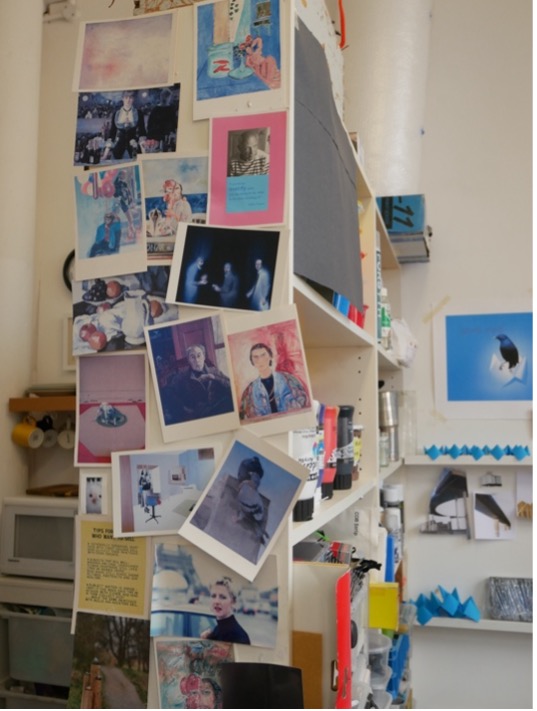
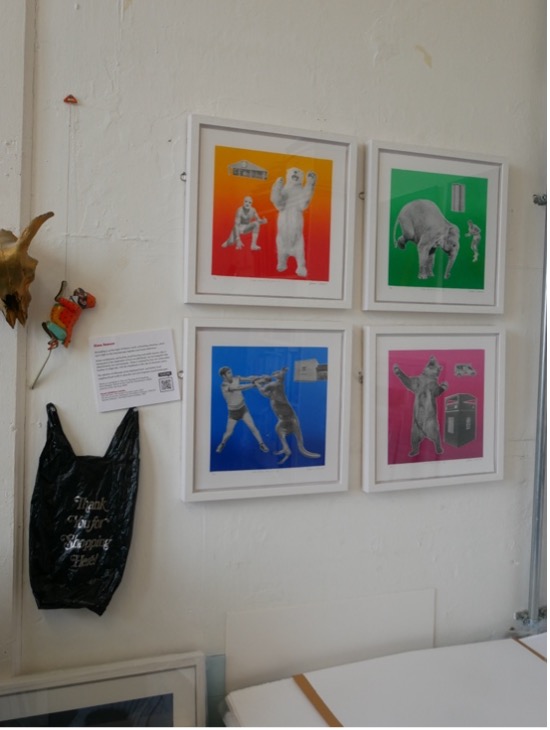
Diane Dawson’s studio. © Alice Cairns
Layers are key to Diane’s authentic worldbuilding. “I enjoy the process of ‘layering’,” she explains, “which is why I am drawn to printmaking where you can build up an image. But I also like to add an almost invisible ‘secret’ layer, in the form of embossed text, UV ink, or gloss overlay, all of which can only be viewed in certain light conditions.” This fascination is evident in her Parks exhibition, where an invisible cat appears under UV light.
While not a photographer, her layered approach appears to replicate photographic techniques. She cites Diane Arbus, Annie Leibovitz, and Bernice Abbot as influences, but it’s Cindy Sherman’s work that resonates most strongly. “I am probably more aligned with Cindy Sherman for her creation of ‘fake’ film stills, the storytelling and the employment of artifice to create characters and control the narrative,” she reveals, evident in her use of photography to create imagined scenes presented as real.

‘Gala Day’ Silkscreen on Mirror & ‘Commonality’ Laser Engraved on Mirror. © Alan Dimmick
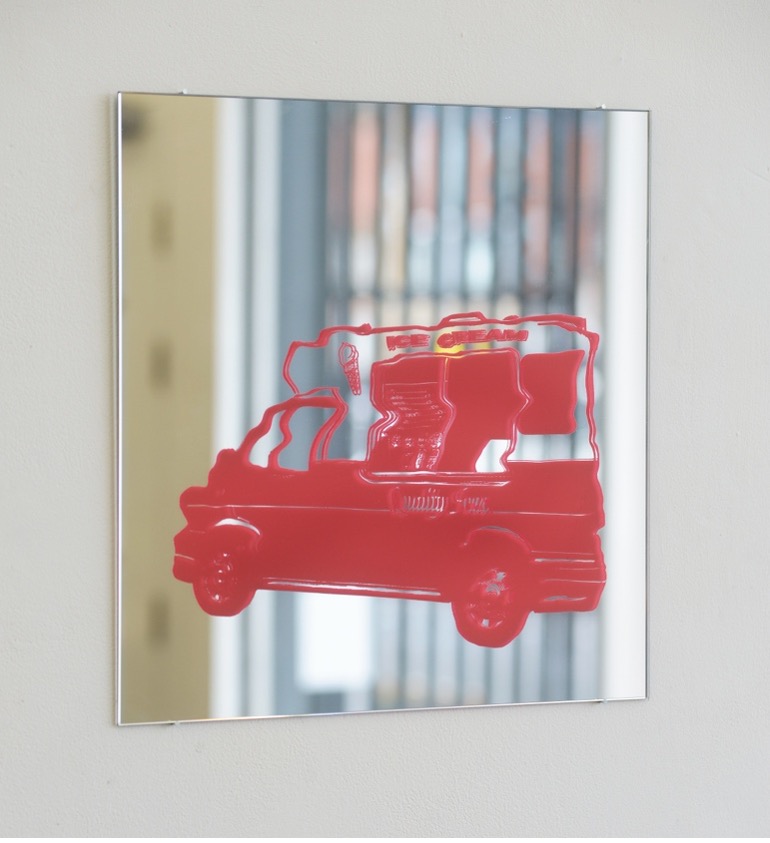
‘The Mirage’ Silkscreen on Mirror. © Alan Dimmick
This blend of influences and techniques has found a nurturing home in Glasgow’s vibrant art scene, particularly within the printmaking community at Glasgow Print Studio. “The shared expertise, both technical and creative, is central to my ability to be an artist/printmaker,” she acknowledges. The immediate neighbourhood of her studio and the print workshop provide another environment to explore, constantly feeding into her creative process.
“I think the Glasgow art scene is a beast with many limbs!” Diane exclaims. “Personally, the printmaking community at Glasgow Print Studio is a hugely valuable support system.”
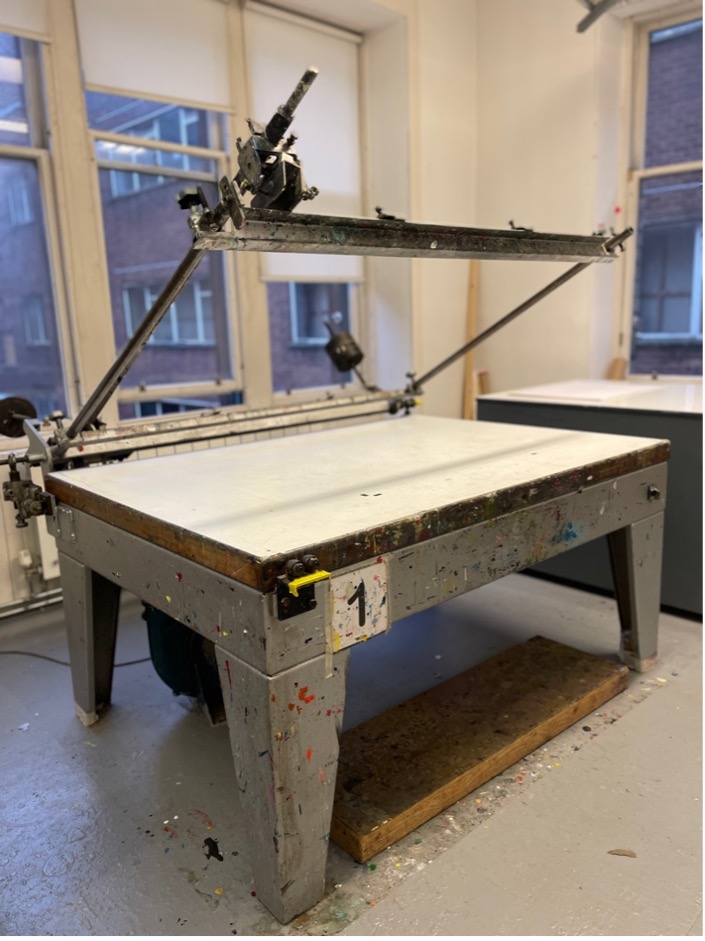
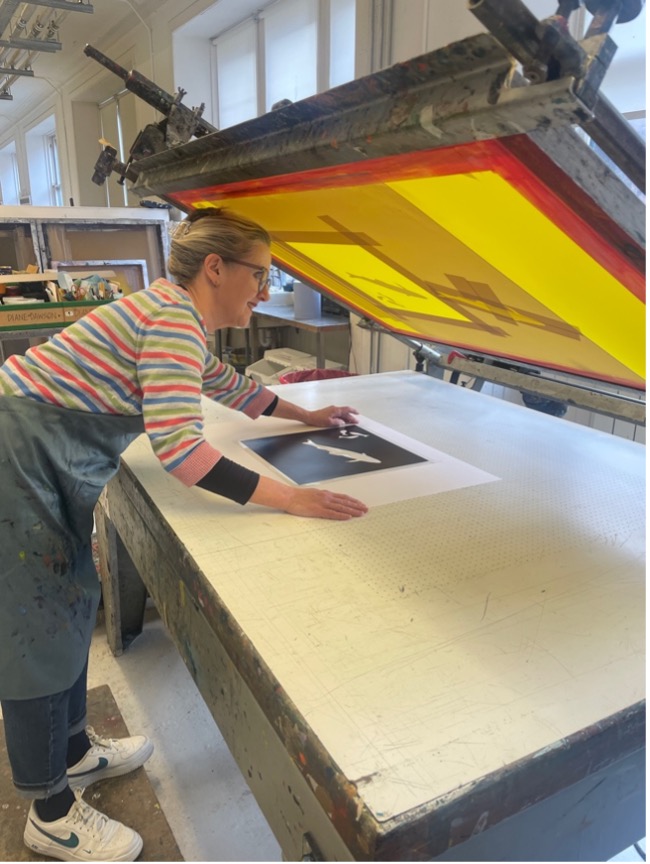
Glasgow Print Studio
As Diane moves beyond her Parks exhibition, she remains curious about her next direction, but her core interests remain unchanged. “I walk through the park every single day,” she says, “and while I enjoy engaging with nature, in terms of my work it is observing behaviour which really holds my interest.”
This daily ritual fuels her ongoing interrogation of the interplay between urban environments and their inhabitants, both human and animal. Through Parks Department and her continuing work, she pushes the boundaries of materials and techniques to visualise her thoughts, crafting a mirror to our modern habitats. Her art reflects not just our surroundings, but the often-overlooked juxtapositions that define our daily lives.
Diane’s unique blend of urban imagery, animal actors, and hidden layers creates a world that is at once familiar and strange. She invites us to see the extraordinary in the ordinary, the wild in the urban, and ourselves in the broader tapestry of our environment. By doing so, she encourages us to question our place within these constructed spaces we inhabit.
For those inspired by Diane’s journey and considering a return to art later in life, her advice is simple yet powerful: “Go for it!”
Alice Cairns
